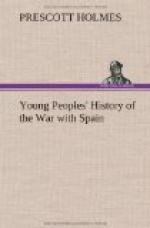That June morning it was thought best to separate and march by two roads, meeting near the Spanish fort. The way of the “Rough Riders” led them up steep hills. Thick bushes grew all around, so that the men could hardly see how to go; the sun rose, and the heat was so awful that some of the men dropped down, faint and sick. Suddenly, from among the trees and bushes came bullets, and the men began to fall, wounded and dead. The Spaniards could not be seen at all, and they were using smokeless powder that left no trace in the air. But our men heard the whizz of the bullets, and felt their sting. The “Rough Riders,” as they pressed on quickly toward the fort, fired again and again into the bushes. At last they met their comrades, who had come by the other road and who had also had a hard fight, and all now toiled up the hill, firing as they went. The Spaniards had to retreat, and could now be seen by our men. The top of the hill was reached at last, the fort was taken, and the Spaniards fled toward Santiago.
This hard fight, which lasted less than two hours, is called the Battle of Las Guasimas, from the name of the poisonous kind of trees in the thicket where the “Rough Riders” were shot down.
[Illustration: Last Stand of the Spaniards at Las Guasimas.]
It would require volumes to tell the bravery and heroism of the men who fought the Spaniards at Las Guasimas. Every one entered into it with enthusiasm. All stood their ground while the Spanish bullets were singing around them, and then, when they were allowed to do so, poured volley after volley into the brush in the direction from which the shots came. Colonel Wood walked along his lines as coolly as though on parade. Lieutenant-Colonel Roosevelt led his men through the brush when the air seemed full of bullets. Captain Capron, the fifth from father to son in the United States army, fell early in the fight, but before he was hit by a Spanish bullet he used his revolver whenever he saw a Spanish head.
[Illustration: Captain Allyn K. Capron.]
Everybody had confidence in their officers and in themselves. If they were hit they fought on if the hurt was not mortal. If they could not stand, they propped themselves against trees, and kept on firing as the line went forward. Men fought with their arms in slings and with bandaged heads.
Lieutenant Thomas, of Captain Capron’s troop, and who was wounded himself during that sweltering June day, tells some interesting stories of the battle. He comes of a fighting family. His father fought in the Civil War, his grandfather was killed in the Mexican War, and three ancestors fell in the war of the Revolution.




